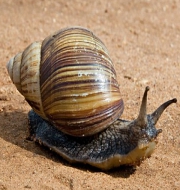Invasive Giant African Land Snail sighted at Goa University
Invasive species of Giant African Land Snail (GALS) was sighted near Goa University campus at Taleigao plateau.
The International Union for Conservation of Nature and Natural resources (IUCN) has listed GALS (Achatina fulica) as one of the world’s 100 most invasive species.
Key Facts
- GALS (Achatina fulica) is gregarious, nocturnal and can be aggressive in its feeding frenzy.
- Their length ranges from 7 cm to 20 cm and the Goa University specimens are identical at 11 cm in length.
- They are known to be dangerous, as they can reproduce faster and take over entire ecosystems.
- Potential threat: (i) To agro-horticultural crops and local flora in Goa (ii) Could also displace local land snails species (Xetatle Konge). (iii) Pose a health threat as they are vectors of human disease such as brain fever (eosinophilic meningitis).
What are invasive species?
- An invasive species is a non-native organism that causes ecological harm after being introduced to a new environment.
- Once they enter a new ecosystem, they can outcompete native organisms for resources like food, especially if they lack natural predators.
- Some invasive species also carry diseases that kill native organisms and many will consume native plants and animals.
- Invasive species can ultimately cause the decline or extinction of native species, decreasing biodiversity in an ecosystem.
- Humans are responsible for the spread of a majority of earth’s invasive species, often carrying them to different parts of the world on ships.
Month: Current Affairs - September, 2016




